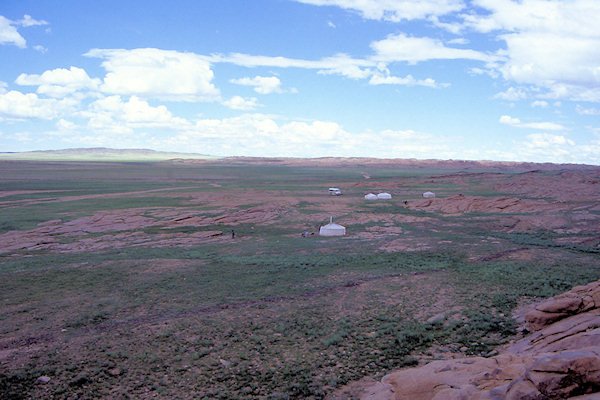Mongolia
The Early Days
Tosontsengel
 |
|||||
Occupiing a pretty valley along the Ider Göl, with forested mountains on all sides, Tosontsengel is a transit hub for west-bound traffic.
Tosontsengel once supported a booming timber trade and it's many wood-fronted buildings, coupled with
unpaved lanes and wandering horseman, give it a Wild West atmosphere.
However, like many businesses in Mongolia, tghis industry is, for the moment, moribund.
On the other hand, retail sales of vodka seem to be booming.
Uliastai
 |
|||||
Uliastai is one of Mongolia's oldest cities, founded by the Manchus (1733) during their reign
in Mongolia.
The old garrison is long gone but the town has retained a pleasant, antiquated feel, with a tree-lined
main street and rows of one-story shops and restaurants.
Javhiant Tolgoi
This hilltop near the river and just north of the main street features a pavilion and three concrete
animals; an elk, ibex and argali sheep.
The vieuws aren't spectacular, but it's worth the short climb to get some notion of how the city is
laid out.
Reaching Uliastai out from Tosontsengel, you have to cross the Zagastain Davaa (Fish Pass). The
road over the pass is in good condition, but take care during bad weather - we even saw snow in July -
the road gets slippery.
Dechindarjaa Hiid
 |
|||||
This small but beautiful temple opened in 1990 and now has 30 monks.
There was an old temple on this same site, but its history is unknown.
The temple is in the ger district, 3,5 km north of the centre.
Altai
 |
|||||
Altai is surrounded by stony treeless hills and a large ger city.
It's a poor city but as it's a long way to anywhere else you'll definitely need to stop for a short while
to refuel and some shopping.
There is a large river on the Uliastai-Altai route, the Zavhan gol, at the town of
Tsagaan-Olom. The bridge had collapsed at the time of our visit. So make local arrangements
for crossing.
Bayanhongor
 |
|||||
One of the most diverse aimags in the Gobi, Bayanhongor has mountains in the north, deserts in
the south, a handful of lakes and rivers, hor springs and a real oasis in the far south of the province.
Bayanhongor, which means 'rich chestnut' (named after the colour of the horses), is home to wild
camals and asses; but most travellers bypass the aimag while travelling along the major southern Ulaan
Baatar - Khovd road.
City
 |
|||||
The broad avenues, cantonment-style apartment blocks and parade ground in front of a monolithic
Government House are straight out a Soviet planner's briefcase.
There are also large patches of waste ground as if the builders gave up halfway through the project.
So, the only reason for staying is, that you have to stop somewhere to get a sleeping-place; there is a
quite nice ger-camp just outside the city.
Lamyn Gegeenii Dedlen Hiid.
The current monastery is home to 40 monks and was built in 1991. The temple is built in the shape of a ger,
though it's actually made out of brick.
Karakorum
 |
|||||
The Erdenezuu Hiid is the reason to come here. built in 1586, Erdenezuu was the first
Buddhist centre in mongolia, and was constructed by Aftehan, a relative of Genghis Khan. The
monastry flourished, and at the height of its glory was host to about 100 temples with 1.000 monks in
residence.
Then came the Stalinist purges of the 1930s. At Erdenezuu, all but three of the 100 temples were destroyed
and an unknown number of monks were either kiled or shipped off to siberia and never heard from agiain.
The tempel remained closed until 1965 when it was permitted to reopen as a museum but not as a place of
worship. It was only with the collapse of communism in 1990 that religious freedom was restored and the
monastry became active again.
Today, Eerdenezuu Hiid still retains much of its former glory, though no doubt it's a shadow of what it
once was.
In 1992 there were already 70 monks on the premises (including students), and no doubt more will arrive.
Restoration of the monastery is one of Mongolia's top cultural projects, but considering that the country
is nearly bankrupt, nu funds are available from the government, but maybe Unesco can give support.
Outside the monastry walls are two turtle rocks (milhii chuluu). There were once four of these
marking the bounderies of ancient Karakorum.
 |
|||||
The monastry is enclosed in an inmense walled compound, measuring 400 metres square. Spaced evenly
along the wall every 15 meters are stupas, with number 108 in total.
Inside is the Lavran Sum (Lavran temple), actually there are three temples: dedicated to the three
stages of Buddha's life: Childhood, adolescense and adulthood.
The temple to the left contains statues of three Buddhas. There is a glass display case housing golden
'wheels of eternity". Other items on display include figurines from the 17th and 18th centuries,
and exotic cakes made in 1965 and still well-preserved, though probbably not too tasty.
The middle temple has a large Buddha statue with two advisors on each side - a doctor and a judge. There
are statues of four disiples standing around the altar: as in many Buddhist temples, threatening-looking
door guards stand on each side of the building's entrance.
The temple to the right has a statue in the middle depicting Buddha as a child. The statue on the right is Bogd Zhonghov, who spread Lamaism in Mongolia. The figure on the left is Janraiseg, the god
of peace.
Behind these temples you can find the Golden Prayer Stupa
